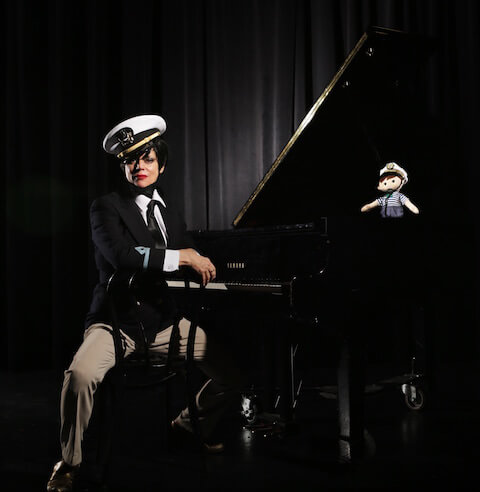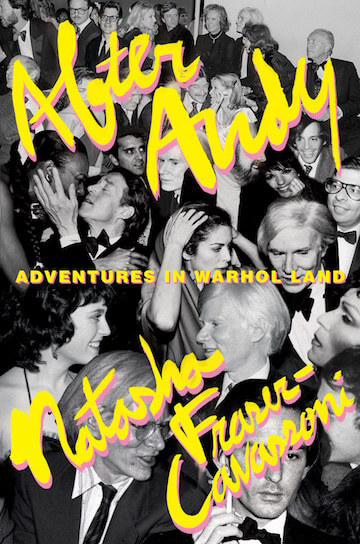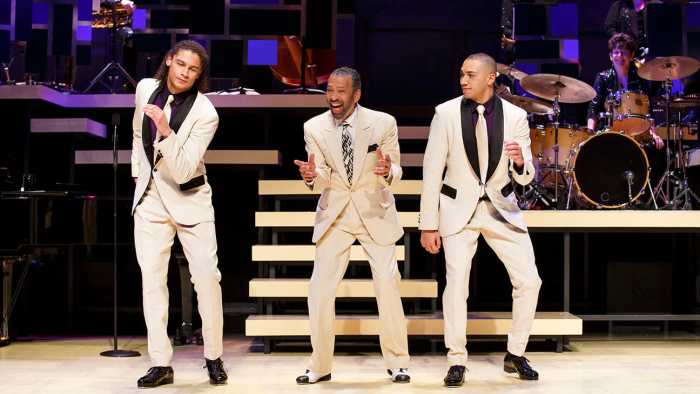Kelly Watkins, artistic director of LGBAC’s Symphonic Band. | DAVID NOH
It’s hard to believe, but the Lesbian & Gay Big Apple Corps turns 35 this year and the LGBAC Symphonic Band performs its holiday concert, “Make the Yuletide Gay!”, on December 12 at Symphony Space (2537 Broadway at 95th St., 8 p.m.; lgbac.org).
I grabbed the chance to talk to its new artistic director, Kelly Watkins, who told me, “This is the first time we’ve incorporated dance, with the Rhythm Nights dance group choreographed by Christopher Anderson, who’s a member of the color guard for the marching component of the Lesbian & Gay Big Apple Corps. For every concert, I typically propose a theme and selections to our board of directors and they approve and make adjustments. This year I chose a series of mostly dance-inspired pieces like “The Nutcracker.” We’re also doing some Shostakovich, some folk dances, “Dance of the Jesters,” which is fun, and a medley of Chanukah music. We are featuring one of our members for 17 years, flutist Craig Devereaux, on ‘Rhapsody for the Flute.’
“We’re also doing the ‘Sandpaper Ballet’ by Leroy Anderson, who really started a very American style of composing. Some of it’s a little folky-hokey but very playable. He did the ‘Typewriter’ ballet, and with this one, you have three soloists playing sandpaper blocks, and they will be three former directors of the symphonic band, two of them founders of it back in 1979.”
Big Apple Corps turns 35, plus a trove of holiday books for the discerning
To add spice to the event, one of my favorite singers, out lesbian Terese Genecco, is also featured.
“She’s great and has hosted and sung at concerts in the past, Watkins said. “We try to also bring in new people, like Doug Quint, who was a trained bassoon player and dropped out to found the Big Gay Ice Cream stores springing up all over the country. Of course, being gay, we have to do some Broadway selections, and this year we are doing ‘A Chorus Line.’”
Warm camaraderie has always been a key allure of LGBAC.
“If you’re new in town, or not, and want to make friends, just join a band,” Watkins said. “It’s the best way to meet people: you already have something in common, especially with LGBT. It’s our 35th year, which is incredible. All the band’s original goals have come to fruition, and we’ve gone above and beyond that. Our concert band has 85 members, a lot of really great talent, with people like doctors who aren’t full-time musicians.
Asked if players have to be gay to join the band, Watkins replied, “No you don’t. We have a fair number of allies and friends who come to play. It’s all-inclusive — everyone’s welcome and there are no auditions. Anyone can come aboard and the only thing we ask is that you’re able to read music relatively well.”
What about the one real flat-noter who shows up and can really bring the band down?
“We’ve been pretty fortunate that that hasn’t happened since I’ve been around,” Watkins said. “I think people can gauge for themselves whether they can keep up. Maybe a certain part’s too difficult for someone who can maybe play one not quite as challenging. People help each other out a lot, and some have become very good friends and develop really strong bonds. There’s no competitiveness, and the great thing is the community that’s been formed.”
Watkins’ whole life is music —her full-time day job is as first trumpet in the US Coast Guard Band.
“Each branch of the military has a band,” she explained. “We are primarily a PR unit for the face of the Coast Guard and we go on national and international tours to spread the good word of the Coast Guard, the good will of America, and patriotism and all that sort of stuff. Where the other military branches have multiple bands with one premiere topnotch band, the Coast Guard only has one. But we hold ourselves to the same level. It’s very competitive, and to get an audition is like any major symphony orchestra.
“I’m very fortunate, as this is one of the few ways you can have a nice, comfortable life as a performing musician, with the same salary and benefits as anyone else in the military. You’re also subject to same rules like Don’t Ask, Don’t Tell, which fortunately does not exist any longer. Being gay in the Coast Guard is not a problem anymore, but when I entered in 2003, Don’t Ask, Don’t Tell was very real and very enforced. I think being a musician worked better for gays in the military than being in the front lines of artillery, as people in the arts tend to be quite open-minded. I’m married now and my wife Amanda and I have a nine-month-old daughter. We got married shortly after all the benefits had been worked out and it was great to be able to have a child.
“If it had been before, there would have been a lot of hurdles, which are still extant, like if you’re stationed in a state that doesn’t recognize same-sex marriage. I’m not the biological mother and would not be able to claim our daughter as a dependent or reap the benefits of dependent pay or childcare at the local development center where we take her for daycare. Don’t Ask, Don’t Tell was never really an issue for me because I knew people who knew I was gay. I felt comfortable and never felt I was in a situation where I got threatened or could be outed in a bad way, but obviously there’s a great number of people who were discharged under Don’t Ask.”
Watkins hails from Henderson in East Texas and said, “I guess I always felt gay but it took me awhile to come to the realization for sure. East Texas is a very religious Southern Baptist area and I was very active in church and my youth group until high school and then not as much. My parents are relatively religious and very conservative overall. It was around grad school time when I put the pieces together, got a grip on it, and started to live my life as a gay person. When I got my Coast Guard job there was kind of a big hesitation accepting the job. But it was a once in a lifetime opportunity, and fortunately I knew people in the band to reach out to them and ask, ‘What do you think?’
“There’s a slew of gay people in military bands and they have been there for years, in all of the military actually. Everyone negotiates it, however they can, and I got some sound advice. Maybe only five years ago, I came out to my parents. I was at least 30, and it was difficult. They love Amanda and accept us, but we don’t talk about it much. My parents are wonderful people but for them it’s easier not to talk about that. It’s fine. I’ve had a lot longer to understand it than they have.”
Lovers Tallulah Bankhead and Toto Koopman at the 1934 premiere of “The Private Life of Don Juan” in Britain.Jean-Noel Liaut’ “The Many Lives of Miss K”/ RIZZOLI
This holiday season we are surrounded by gadgets galore, but I still think a good book is the best gift to give, and there’s a slew of honeys to choose from. Jean-Noel Liaut’s fascinating “The Many Lives of Miss K.” is the first biography of the bisexual adventuress Toto Koopman. You may not know the name, but you have definitely seen her in any number of iconic fashion photographs taken in the 1930s by the likes of Hoyningen-Huene, Beaton, Steichen, and Horst. Her eerily aristocratic Dutch-Indonesian looks — similar to that later supermodel Pat Cleveland — made her one of the great beauties of her era and her sexually rapacious life was more akin to what a man could enjoy than a woman. And there was a brain and burning life force behind that creamy mask. She was not only the lover of press magnate Lord Beaverbrook (and his son!), Randolph Churchill (Winston’s son), and Tallulah Bankhead, but, fluent in six languages, Koopman was also a spy for the Italian resistance and almost died in the concentration camp at Ravensbruck.
After the war, she met Erica Brausen, a German art dealer, who became her lifelong partner and with whom she opened the legendary Hanover Gallery in London, showing Lucian Freud, Henry Moore, Marcel Duchamp, and the trailblazing artist she discovered, Francis Bacon. Always open about her sexuality, people were drawn to the gallery for the chance to see this notorious lesbian couple (at a time when homosexuality was a criminal offense in Britain) as much as the extraordinary art on exhibit.
When Koopman died in 1991, at 82, Brausen (who soon followed her in death) sequestered herself with Toto’s body for eight days, going out only to buy fresh roses to arrange about the beloved corpse’s face each morning.
A more recent icon of beauty and fashion, Loulou de la Falaise, died in 2011, and her beyond-elegant life is celebrated in a sumptuous self-titled Rizzoli coffee table book by Ariel de Ravenel and Natasha Fraser-Cavassoni. Much of the book is a graceful oral history, with memories of her inimitable glamour and grace from intimates — Diane von Furstenberg, Marisa Berenson, Manolo Blahnik, Pierre Bergé, the partner of Yves Saint Laurent with whom de la Falaise worked for years, turning out his extraordinary collections.
I had an unforgettable meeting with her at Studio 54 when Saint Laurent launched his Opium perfume. I was standing in the club’s infamous balcony when she suddenly materialized next to me, having escaped her intense clique of Saint Laurent, Halston, and Warhol downstairs. She admired my Castelbajac jumpsuit, offered me a sip of her whiskey and soda, and we spent the evening together talking about everything from the famous women her uncle, Henri de la Falaise, married (Gloria Swanson, “zat beetch” Constance Bennett) to her preference in Japanese designers (Kenzo over Issey Miyake) to her work (“Every season, Yves and I look at each other and say, ‘So how do we create a new skirt and blouse?’”). She was the most hypnotically seductive, chic woman I have ever met. and each time I saw her again she was just as lovely, just as stylish, and just as real.
John Gruen has for decades been one of New York’s foremost cultural chroniclers, be it through his perceptive writing or marvelous photographs, and these two gifts are combined in “My New York,” a mesmerizing ode to this greatest of cities. Half of this book, from the brand new and exciting Turning Point Press, are Gruen’s vivid time capsule grab shots of our town and its largely anonymous populace at work and leisure. The other half is comprised of his telling, canny thumbnail sketches of the many artists he’s encountered, a stunningly varied group that made up the fabulous tapestry of Manhattan before the invasion of one-percenters and Starbucks — Arthur Miller, Keith Haring, Leonard Bernstein, Comden & Green, Larry Rivers, Virgil Thomson, Bobby Short, and Warhol drag star Mario Montez, among many.
An absolute sure-fire book bet is Matthew Kennedy’s terrific, comprehensive “Roadshow!” which is about those huge, often bloated 1960s movie musicals the big studios launched in the wake of the dazzling success of “My Fair Lady” and “The Sound of Music.” These films were a major influence on anyone growing up in those years — events — with their musical overtures and exit themes, intermissions, glossy souvenir programs, and incredibly enticing hype preceding them. (I can still absolutely recall the thrill, as a kid in Hawaii, of seeing the trailer for “Funny Girl” that was about the filming of the “Don’t Rain on My Parade” number.) These musicals mostly flopped, bankrupting their studios, but God were they fun, for all of their bowdlerizations and miscastings.
Kennedy is unforgiving about many of them — I thought I was a curmudgeon! — and he and I have had some lively arguments about many of these films. I am probably in the minority who doesn’t think Vanessa Redgrave was an inferior Guinevere to Julie Andrews’ stage rendition in “Camelot.” Director Joshua Logan, clumsy as he could be, got it right when he said he wanted to cast a woman who looked worth losing a kingdom over, and she is sumptuous — a ravishingly hippie Medieval queen (in 1967) with purringly seductive vocals that, while not approximating Andrews’ pristine tones, more accurately convey the character’s sensuality and satirical wit.
And, not to further Julie-bash — she’s undoubtedly great in her way — but for musical heroines, I far prefer Petula Clark in Francis Ford Coppola’s exuberantly counter-culture “Finian’s Rainbow” and Herbert Ross’ “Goodbye Mr. Chips” (a true neglected classic) to Andrews, who, while gorgeous vocally, could be so antiseptic. Clark, with her experienced pop chops, brought a natural acting talent and her distinctive, white-soul melismata effectively to both roles. She’s the definitive, sexy, spunky colleen in the first (I could watch her seductive “Old Devil Moon” duet with Don Francks endlessly). She’s luminous, womanly in “Mr. Chips,” while Peter O’Toole gives his greatest performance as the shy, heartbreakingly gallant schoolmaster — the two of them warbling Leslie Bricusse’s heavily maligned but, I think, lovely score. I defy anyone to watch Clark sing “You and I” to him and not get at least a little misty.
Of course all this is so subjective and, in my case, so intensely wrapped up in childhood nostalgia. I adore Streisand’s Dolly and wish more coverage had been given to my favorite of her musicals, “On a Clear Day,” which I constantly battle to come to aesthetic terms with.
Just get this book and blissfully immerse yourself in Kennedy’s scrupulous research, which goes behind the scenes and magically makes the making of these indelible misses and occasional triumphs absolutely come alive.
Contact David Noh at Inthenoh@aol.com and check out his blog at http://nohway.wordpress.com.




































